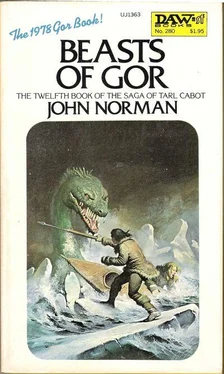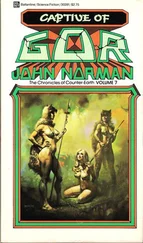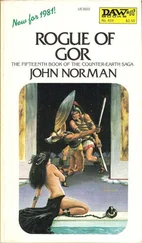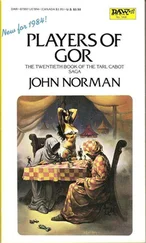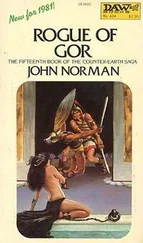“There was only one ship,” I said. “And I had not realized the difficulty of getting the supplies to where they would be most needed.”
“Do my ears deceive me?” asked Imnak. “I cannot believe what I am hearing. Did I hear a white man say be had made a mistake?”
“I made a mistake,” I said. “One who is wise in the south may be a fool in the north.”
This admission took Imnak aback for a moment.
“You are wiser than I,” I added, for good measure.
“No,” he said, “you are wiser than I.”
“Perhaps I am wiser in the south,” I said, “but you are wiser in the north.”
“Perhaps,” he said.
“And you are a great hunter,” I said.
He grinned. “I have done a little hunting,” he said.
“Rouse up! Rouse up!” called a guard, beating on the wooden bars of the pen with his spear. “It is time for your gruel, and thence to your labors.”
Two guards were then amongst us, prodding men awake and up.
“Release this man from the chain,” said Ram, indicating me. “Yesterday he was beaten with the snake.”
It was not unusual that men died under the lash of the snake, that heavy coil laced with wire and flecks of iron.
“It is ordered,” said the guardsman, “that he labors today.”
Ram looked at me, startled. I was already on my feet. My lovely captor, I recalled, had said that I would labor today. I was to well understand whose prisoner I was. “I am hungry,” I said.
The guard backed away from me. He went to check the ankle chains of the others.
We were soon shuffled from the pen. In making our way to the cook shack we passed the large, wooden dais on which the whipping frame had been erected. It was some twelve feet square, and some four feet in height, its surface reached by steps. The whipping frame itself, vertical, consisted of two heavy uprights, some six inches square and eight feet high, and a crossbeam, some six inches square and some seven feet in length. Each upright was supported by two braces, each also six inches square. A heavy ring was bolted on the underside of the high crossbeam; it was from this ring that a prisoner, bound by the wrists, might be suspended. A matching ring was bolted in the beams of the dais, under the upper ring. It was to the lower ring that the prisoner’s feet, some six inches above the wood, crossed and tied, might be bound. This prevents undue swinging under the lash.
We were knelt outside the cook shack. We were given wooden bowls. We were served gruel, mixed with thick chunks of boiled tabuk, by the blond, she who had once been Barbara Benson, now Thimble, and the dark-haired girl, who had once been the rich girl, Audrey Brewster, now the slave girl, Thistle. Thimble had been made first girl. She made Thistle carry the metal bucket of gruel while she, with a ladle, filled the bowls. Neither girl any longer wore the strings on her throat, identifying them as a hunter’s beasts, nor her brief furs nor the fur wrappings on their feet. Both had been placed in belted woolen camisks, an open-sided garment sometimes worn by female slaves. Though it was chilly both were barefoot.
Blond Thimble cried out, seized by one of the men in the chain. She struck at him with the ladle. She was thrown to the ground beneath him. Instantly guards were on the fellow, striking him with spear butts and pulling him from the girl. They struck him cruelly. “She is for the guards,” they told him.
Terrified, Thimble, her camisk half torn away, stumbled back, away from the chain.
“Fill their bowls again,” said the head guard. ‘They have much work to do today.”
Thimble and Thistle began again at the far end of the line to my right. They swayed back, frightened, as far as they could from the line, in their serving.
They knew the terror of slave girls, among men hungry for women.
There were some forty men in my chain. Along the some seventy pasangs of the wall there were several such chains, with their own pens and facilities. Somewhere between three and four hundred men, with their guards, labored at one place or another along the wall. I do not think it was a mistake that I was in one of the more central chins. My lovely captor, doubtless, had so decreed it. She was quite proud of my capture, which she regarded as a function of her own merits. She wanted me in a position of maximum security, nearer the wall’s center, closer to her headquarters. Too, I think she relished the pleasure of seeing me in her chains.
We were marched past the high platform overlooking the wall.
She was on the platform, with two guards.
“She is up early this morning,” said one of the men.
Near the platform there were piled some logs and heavy stones, carried there by other laborers the preceding afternoon. Tools, also, wrapped in hide, were there.
“Lift these logs,” said a guard. “Carry these stones.”
I, with Ram and Imnak, and Tasdron, who had been the captain in the fee of Samos, he whose ship had been lost to the tarnsmen, shouldered one of the logs.
My lovely captor looked down on us. Her face was flushed with pleasure.
“She wears a man’s furs,” said Ininak.
That was true, at least from the point of view of a red hunter. Women of the red hunters are furred differently from the hunters. Their boots, soft, of sleenskin, are high, and reach the crotch, instead of the knee. Instead of trousers of fur they wear brief panties of fur. When they cover their breasts it is commonly with a shirt of beaded lartskin. In cold weather they, like the men, wear one or more hooded parkas of tabuk hide. Tabuk hide is the warmest pelt in the arctic. Each of the hairs of the nothern tabuk, interestingly, is hollow. This trapped air, contained in each of the hollow hairs, gives the fur excellent insulating properties. Air, incidentally, is extremely important, generally, in the effectiveness of the clothing of the red hunters. First, the garments, being of hide, are windproof, as most other garments are not. Cold air, thus, cannot penetrate the garment. The warming factor of the garment is a function of air trapped against the skin. This air, inside the garment, is warmed by the body, of course, The garment, because of the hood, and the weight of the garment on the shoulders, tends to trap this warm air inside. It does not escape from the bottom because warm air, being less dense than cold air, tends to rise. The major danger of these garments, interestingly, is the danger of the wearer becoming overheated. Perspiration in the arctic winter, which can freeze on the body, and soak the clothing, which can then become like ice, brittle and useless, is a peril to be avoided if at all possible. Yet the garment’s design permits this danger to be nullified. When the hunter becomes overheated he pulls down the neck of the parka. This permits the warm air to escape and its place is taken by fresh, cold air from the bottom. He thus, by closing or opening the throat of the garment, regulates its effectiveness according to his needs. The warmth of most normal clothing, incidentally, is a function of layers of cloth, not of trapped, warmed air. These many layers of clothing are, of course, heavy, cumbersome and difficult to work in. Also, of course, since this sort of clothing is not normally windproof cold air penetrates the garment and, meeting the warm air of the body, tends to precipitate moisture. The garments thus become wet and more heavy, and more dangerous, at low temperatures. Also, there is no simply way of avoiding this danger. One may, of course, remove layers of clothing, but this, in arctic temperatures, can be dangerous in itself. Also, when one wishes to replace the clothing, it may be, by then, frozen. At arctic temperatures moisture in a garment can turn to ice in a matter of seconds. The armholes in a parka, incidentally, are cut large enough to allow a man to pull his arms and hands inside and warm them, if he wishes, against the body. The clothing of the arctic hunter seems ideally suited to his needs in the north. It is warm, light in weight and permits great freedom of movement.
Читать дальше
